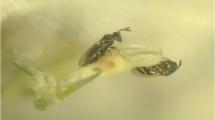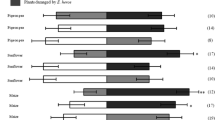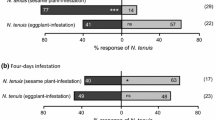Abstract
The role of volatile infochemicals emitted by feces of larvae in the host-searching behavior of the parasitoidCotesia rubecula was evaluated during single- and dual-choice tests inside a wind tunnel. The following treatments were tested: feces produced by second and fourth instars ofPieris rapae (preferred host), second instars ofP. brassicae (inferior host), second instars ofP. napi (nonhost), and wet feces of second instars ofP. rapae. During a single-choice situation females ofC. rubecula oriented to all types of feces tested. When a preference was to be made,C. rubecula preferred feces of second instars ofP. rapae over that of fourth, feces ofP. rapae over that ofP. brassicae, feces ofP. napi over that ofP. brassicae, and wet over normal host feces. No preference was exhibited between feces of second instars ofP. napi and that of second instars ofP. rapae. The relative importance of infochemicals from host feces versus plant damage caused by host larvae to the searching behavior ofC. rubecula was also evaluated. Plant damage was more important to the searching females than host feces when feces were present in specific concentrations in relation to damage. The volatiles released by normal and wet feces of second instars ofP. rapae, wet feces of fourth instars ofP. rapae, and normal and wet feces ofP. brassicae were collected and identified. Overall, 85 chemical compounds were recorded belonging to the following chemical groups: alcohols, ketones, aldehydes, esters, isothiocyanates, sulfides, nitriles, furanoids, terpenoids and pyridines. The blend of chemicals emitted by feces of different instars ofP. rapae and different species ofPieris exhibited an instar and species specificity in both quantity and quality. Wetting of normal feces increased the amount of volatile chemicals released, and it was also responsible for the appearance of new compounds. The role of feces of larvae in the host-seeking behavior ofC. rubecula is discussed.
Similar content being viewed by others
References
Agelopoulos, N.G., andKeller, M.A. 1994a. Plant-natural enemy association in the tritrophic system,Cotesia rubecula-Pieris rapae-Brassicaceae (Cruciferae). I. Sources of infochemicals.J. Chem. Ecol. 20(7):1725–1734.
Agelopoulos, N.G., andKeller, M.A. 1994b. Plant-natural enemy association in the tritrophic system,Cotesia rubecula-Pieris rapae-Brassicaceae (Cruciferae). II. Preference ofC. rubecula for searching and landing.J. Chem. Ecol. 20(7):1735–1748.
Agelopoulos, N.G., andKeller, M.A. 1994c. Plant-natural enemy association in the tritrophic system,Cotesia rubecula-Pieris rapae-Brassicaceae (Cruciferae). III. Collection and identification of plant and feces volatiles.J. Chem. Ecol. 20(8):1955–1967.
Auger, J., Lecomte, C., Paris, J., andThibout, E. 1989. Identification of leek-moth and diamondback-moth frass volatiles that stimulate the parasitoidDiadromus pulchellus.J. Chem. Ecol. 15:1391–1399.
Bailey, S.D., Basinet, J.L., Driscoll, J.L., andMcCarthy, A.I. 1961. The volatile sulfur compounds of cabbage.J. Food Sci. 26:163–170.
Blaakmeer, A., Geervliet, J.B.F., Van Loon, J.J.A., Posthumus, M.A., Van Beek, T.A., andDe Groot, A.E.V. 1994. Comparative headspace analysis of cabbage plants damaged by two species ofPieris caterpillars: Consequences for in-flight host location byCotesia parasitoids. Entomol. Exp. Appl. 73:175–182.
Buttery, R.G., Guadagni, D.G., Ling, L.C., Seifert, R.M., andLipton, W. 1976. Additional volatile components of cabbage, broccoli, and cauliflower.J. Agric. Food Chem. 24(4):829–832.
Cole, R.A. 1976. Isothiocyanates, nitriles and thiocyanates as products of autolysis of glucosinolates in Cruciferae.Phytochemistry 15:759–762.
Cole, R.A. 1980a. Volatile components produced during ontogeny of some cultivated Crucifers.J. Sci. Food Chem. 31:549–557.
Cole, R.A. 1980b. The use of porous polymers for the collection of plant volatiles.J. Sci. Food Chem. 31:1242–1249.
Cortesero, A.M., Monge, J.P., andHuignard, J. 1993. Response of the parasitoidEupelmus vuilleti to the odours of the phytophagous host and its host plant in an olfactometer.Entomol. Exp. Appl. 69:109–116.
Dicke, M., Van Beek, T.A., Posthumus, M.A., Ben Dom, N., Van Bokhoven, H., andDe Groot, A.E. 1990. Isolation and identification of volatile kairomone that affects acarine predator-prey interactions. Involvement of host plant in its production.J. Chem. Ecol. 16(2):381–396.
Ding, D., Swedenborg, P.D., andJones, R.L. 1989. Chemical stimuli in host-seeking behavior ofMacrocentrus grandii (Hymenoptera: Braconidae).Ann. Entomol. Soc. Am. 82(2):232–236.
Eller, F.J., Tumlinson, J.H., andLewis, W.J. 1988a. Beneficial arthropod behavior mediated by airborne semiochemicals. II. Olfactometric studies of host location by the parasitoidMicroplitis croceipes (Cresson) (Hymenoptera: Braconidae).J. Chem. Ecol. 14(2):425–434.
Eller, F.J., Tumlinson, J.H., andLewis, W.J. 1988b. Beneficial arthropod behavior mediated by airborne semiochemicals: Sources of volatiles mediating the host-location flight behavior ofMicroplitis croceipes (Cresson) (Hymenoptera: Braconidae), a parasitoid ofHeliothis zea (Boddie) (Lepidoptera: Noctuidae).Environ. Entomol. 17(4):745–753.
Elzen, G.W., Williams, H.J., Vinson, S.B., andPowell, J.E. 1987. Comparative flight behavior of parasitoidsCampoletis sonorensis andMicroplitis croceipes.Entomol. Exp. Appl. 45:175–180.
Evans, K.A., andAllen-Williams, L.J. 1992. Electroantennogram responses of the cabbage seed weevil,Ceutorhychus assimilis, to oilseed rape,Brassica napus ssp.oleifera, volatiles.J. Chem. Ecol. 18(9):1641–1652.
Fukushima, J., Kuwahara, Y., andSuzuki, T. 1989. Isolation and identification of a kairomone responsible for the stinging behavior ofBracon hebetor Say (Hymenoptera: Braconidae) from feces of the almond mothCadra cautella Walker.Agric. Biol. Chem. 53(11):3057–3059.
Geervliet, J.B.F., andBrodeur, J. 1992. Host species affecting the performance of the larval parasitoidsCotesia glomerata andC. rubecula (Hymenoptera: Braconidae). II. Comparative suitability of threePieris species (Lepidoptera: Pieridae).Meded. Fac. Landbouwwet. Rijksuniv. Gent 57(2b):547–549.
Geervliet, J.B.F., Van Aaken, R., Savelkoul, C., Smitte, S.M., Brodeur, J., Vet, L.E.M., andDicke, M. 1993. Comparative approach to infochemical use by parasitoids for the case ofCotesia glomerata andCotesia rubecula.Proc. Exp. Appl. Entomol. 4:33–38.
Geervliet, J.B.F., Vet, L.E.M., andDicke, M. 1994. Volatiles from damaged plants as major cues in long-range host-searching by the specialist parasitoidCotesia rubecula.Entomol. Exp. Appl. 73:289–297.
Geervliet, J.B.F., Vet, L.E.M., andDicke, M., 1995. Innate responses ofCotesia glomerata andC. rubecula (Hymenoptera: Braconidae) to plant-herbivore complexes.J. Insect Behav. (Submitted).
Kaiser, L., andCarde, R.T. 1992. In-flight orientation to volatiles from the plant-host complex inCotesia rubecula (Hym.: Braconidae): increased sensitivity through olfactory experience.Physiol. Entomol. 17:62–67.
Keller, M.A. 1990. Responses of the parasitoidCotesia rubecula to its hostPieris rapae in a flight tunnel.Entomol. Exp. Appl. 57:243–249.
Lecomte, C., andThibout, E. 1986. Analyse, dans deux types d'olfactomètres, du comportement de quête des femelles deDiadromus pulchellus en présence d'odeurs du phytophage-hôte et du végétal attaqué ou non.Entomophaga 31(1):69–78.
Lecomte, C., andThibout, E. 1993. Pre- and post-imaginal experience in a specialist parasitoidDiadromus pulchellus (Hym.: Ichneumonidae).Entomophaga 38(2):175–184.
Lewis, W.J., andJones, R.L. 1971. Substances that stimulate host-seeking byMicroplitis croceipes (Hymenoptera: Braconidae), a parasitoid ofHeliothis species.Ann. Entomol. Soc. Am. 64(2):471–473.
Loke, W.H., Ashley, T.R., andSailer, R.J. 1983. Influence of fall army worm,Spodoptera frugiperda (Lepidoptera: Noctuidae) larvae and corn plant damage on host finding inApanteles marginiventris (Hymenoptera: Braconidae).Environ. Entomol. 12:911–915.
Mattiacci, L., andDicke, M. 1995. The parasitoidCotesia glomerata (Hymenoptera: Braconidae) discriminates between first and fifth larval instars of its hostPieris brassicae on the basis of contact dues from frass, silk and herbivore damaged leaf-tissue.J. Insect Behav. 8:485–498.
Mattiacci, L., Dicke, M., andPosthumus, M.A. 1994. Induction of parasitoid attracting synomone in Brussels sprouts plants by feeding ofPieris brassicae larvae: Role of mechanical damage and herbivore elicitor.J. Chem. Ecol. 20:2229–2247.
Nadel, H., andVan Alphen, J.J.M. 1987. The role of host-and host-plant odours in the attraction of a parasitoid,Epidinocarsis lopezi, to the habitat of its host, the cassava mealy bug,Phenacoccus manihoti.Entomol. Exp. Appl. 45:181–186.
Nealis, V. 1986. Responses to host kairomones and foraging behavior of the insect parasiteCotesia rubecula (Hymenoptera: Braconidae).Can. J. Zool. 64:2393–2398.
Nealis, V. 1990. Factors affecting the rate of attack byCotesia rubecula (Hymenoptera: Braconidae).Ecol. Entomol. 15:163–168.
Nordlund, D.A., andLewis, W.J. 1985. Response of females of the braconid parasitoidMicroplitis demolitor to feces of the noctuids,Heliothis zea andTrichoplusia ni and to 13-methylhentriacontane.Entomol. Exp. Appl. 38:109–112.
Nordlund, D.A., andSauls, C.E. 1981. Kairomones and their use for management of entomophagous insects. XI. Effect of host plants on kairomonal activity of feces fromHeliothis zea larvae for the parasitoidMicroplitis croceipes.J. Chem. Ecol. 7(6):1057–1061.
Potting, R.P.J., Vet, L.E.M., andDicke, M. 1995. Host microhabitat location by the stemborer parasitoidCotesia flavipes: The role of herbivore volatiles and locally and systemically induced plant volatiles.J. Chem. Ecol. 21:525–539.
Ramachandran, R., Norris, D.M., Phillips, J.K., andPhillips, T.W. 1991. Volatiles mediating plant-herbivore-natural enemy interactions: Soybean looper feces volatiles, 3-octanone and guaiacol, as kairomones for the parasitoidMicroplitis demolitor.J. Agric. Food Chem. 39:2310–2317.
Sato, Y. 1979. Experimental studies on parasitization byApanteles glomeratus. IV. Factors leading a female to the host.Physiol. Entomol. 4:63–70.
Shenefelt, R.D. 1972. Braconidae 4. Microgasterinae, Apanteles, p. 615,in van der Vecht M. and R. Shenefelt (eds.) Hymenopterum Catalogus, Vol. 7. Junk Publishers, The Hague, The Netherlands.
Steinberg, S., Dicke, M., andVet, L.E.M. 1993. Relative importance of infochemicals from first and second trophic level in long-range host location by the larval parasitoidCotesia glomerata.J. Chem. Ecol. 19:47–59.
Takabayashi, J., andTakahashi, S. 1989. Effects of host pellet and synthetic kairomones on host-searching and postoviposition behavior ofApanteles kariyai, a parasitoid ofPseudaletia separata.Entomol. Exp. Appl. 52:221–227.
Takabayashi, J., Takahashi, S., Dicke, M., andPosthumus, M.A. 1995. Developmental stage of herbivorePseudaletia separata affects production of herbivore-induced synomone by corn plants.J. Chem. Ecol. 21:273–287.
Thibout, E., Guillot, J.F., andAuger, J. 1993. Microorganisms are involved in the production of volatile kairomones affecting the host seeking behavior ofDiadromus pulchellus, a parasitoid ofAcrolepiopsis assectella.Physiol. Entomol. 18:176–182.
Tollsten, L., andBergström, G. 1988. Headspace volatiles of whole plants and macerated plant parts ofBrassica andSinapis.Phytochemistry 27:2073–2077.
Turlings, T.C.J., andTumlinson, J.H. 1992. Synthetic release of chemical signals by herbivore-injured corn.Proc. Natl. Acad. Sci. U.S.A. 89:8399–8402.
Turlings, T.C.J., Tumlinson, J.H., andLewis, W.J. 1990. Exploitation of herbivore-induced plant odors by host-seeking parasitic wasps.Science 250:1251–1253.
Turlings, T.C.J., Tumlinson, J.H., Eller, F.J., andLewis, W.J. 1991. Larval-damaged plants: Source of volatile synomones that guide the parasitoidCotesia marginiventris to the microhabitat of its host.Entomol. Exp. Appl. 58:75–82.
Usher, B.F. 1984. Housecleaning behavior of a herbivorous caterpillar: Selective and behavioral implications of feces-throwing byPieris rapae larvae. PhD dissertation. Cornell University, Ithaca, New York.
Van Leerdam, M.B., Smith, J.W., Fuchs, J.R., andFuchs, T.W. 1985. Feces-mediated, host finding behavior ofCotesia flavipes, a parasite ofDiatrea saccharalis (Lepidoptera: Pyralidae).Ann. Entomol. Soc. Am. 78(5):647–650.
Vet, L.E.M., andDicke, M. 1992. Ecology of infochemicals used by natural enemies in a tritrophic context.Annu. Rev. Entomol. 37:141–172.
Vinson, S.B. 1976. Host selection by insect parasitoids.Annu. Rev. Entomol. 21:109–133.
Vinson, S.B. 1984. How parasitoids locate their hosts: a case of insect espionage. pp. 325–384,in T. Lewis (ed.). Insect Communication. Academic Press, New York.
Wallbank, B.E., andWheatley, G.A. 1976. Volatile constituents from cauliflower and other crucifers.Phytochemistry 15:763–766.
Whitman, D.W., andEller, F.J. 1990. Parasitic wasps orient to green leaf volatiles.Chemoecology 1:69–75.
Wiskerke, J.S.C., andVet, L.E.M. 1994. Foraging for solitary and gregariously feeding caterpillars: A comparison of two related parasitoid species.J. Insect Behav. 7:585–603.
Author information
Authors and Affiliations
Rights and permissions
About this article
Cite this article
Agelopoulos, N.G., Dicke, M. & Posthumus, M.A. Role of volatile inforchemicals emitted by feces of larvae in host-searching behavior of parasitoidCotesia rubecula (Hymenoptera: Braconidae): A behavioral and chemical study. J Chem Ecol 21, 1789–1811 (1995). https://doi.org/10.1007/BF02033677
Received:
Accepted:
Issue Date:
DOI: https://doi.org/10.1007/BF02033677




